|
|
The
Sporting Breeds
page 1
page 3 |
|
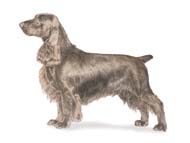 Field
Spaniel Field
Spaniel
Known for its level-headedness and
perseverance, the Field Spaniel is a medium-sized flushing spaniel, built
for activity and endurance in heavy cover and water. One of the rarest
spaniel breeds (they nearly went extinct!), the Field possesses moderately
long, pendulous ears and a single coat that is both dense and
water-repellent. He can be black, liver or golden liver in color; tan
points or white markings are acceptable.
A Look Back
The Field Spaniel originated in England in the mid-1800s and was used to
find, flush and retrieve both fur and feather from land and water. The
breed was introduced to America in the 1880’s but did not become a
distinct breed from Cockers until the 20th century, when it was decided
that anything above 25 pounds qualified as a Field Spaniel (the larger of
the two types of land spaniel).
Right Breed for You?
A docile and fun-loving companion, the Field Spaniel sticks close to his
family and wants to participate in any and all family activities. They may
be initially reserved when meeting strangers, but quickly warm up to
people. They require regular walks, but their medium-length coat (less
than other Spaniel breeds) makes grooming fairly easy, requiring only
weekly brushing and occasional trimming. |
|
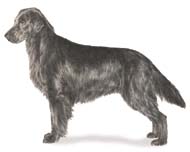 Flat
Coated Retriever Flat
Coated Retriever
Although his tail never stops
wagging, the Flat-Coated Retriever is suited for hard work. Originally bred
to flush and retrieve both upland game and waterfowl, he transfers his
determination, desire and verve on the hunting field to everyday life,
enthusiastically participating in family activities and in the show,
obedience and agility rings. Slightly racier and more moderate in bone than
other retriever breeds, the Flat-Coat has a solid black or liver-colored
coat that protects him from the elements and lies straight and flat.
A Look Back
The Flat-Coat’s ancestry includes the "Retriever Proper," a
cross-breed emerging from the Large Newfoundland, setter, sheepdog, and
spaniel-like water dogs. These retrievers were invaluable to fishermen and
often traded between Britain and North America, where they became known as
generic "Labrador" dogs. Eventually, a breed known as the
Wavy-Coated (subsequently Flat-Coated) Retriever appeared and became
distinct to these "Labrador" dogs.
Right Breed for You?
Described by all who meet him as cheerful, optimistic and good-humored, the
Flat-Coat excels as a family companion. He requires regular vigorous
exercise, however, due to his working heritage. Dog sports such as
obedience, agility and hunt tests provide both mental and physical exercise.
Among Sporting breeds, the Flat-Coat is easy to maintain, needing only
occasional brushing and bathing. |
|
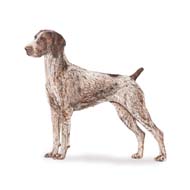 German
Shorthaired Pointer German
Shorthaired Pointer
A versatile hunter and
all-purpose gun dog, the German Shorthaired Pointer possesses keen scenting
power and high intelligence. The breed is proficient with many different
types of game and sport, including trailing, retrieving, and pointing
pheasant, quail, grouse, waterfowl, raccoons, possum, and even deer. A
medium-sized breed, he has an aristocratic bearing and can be solid liver or
liver and white in color.
A Look Back
The origin of the German Shorthaired Pointer is not clear, but the source of
the breed seems to have been the German Bird Dog, related to the old Spanish
Pointer, and various crossings with local German scent hounds and track and
trail dogs. When the Germans introduced the English Pointers to lend
elegance to the German Shorthaired Pointer prototype, the result was a
utility dog that combined sporting virtue with clean lines, good looks and
sound temperament.
Right Breed for You?
The German Shorthaired Pointer thrives as part of an active family. He is an
even-tempered, intelligent and loyal family watchdog that has enthusiasm for
its work. An athlete, he can adapt to his living situation, but requires
consistent exercise. The GSP’s short coat sheds, but grooming is minimal.
|
|
German Wirehaired
Pointer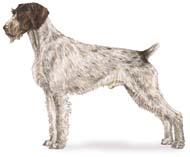
When the Germans wanted a
dog that could do it all, they created the German Wirehaired Pointer, a
versatile, multi-purpose hunting dog. Strong and medium-sized, with a
typical Pointer personality, the breed’s most distinctive feature is its
functional wiry coat. Weather resistant and water-repellant, the outer
coat is straight, harsh, wiry and flat lying, which helps to protect the
dog against rough cover while hunting. The coat must be liver and white in
color.
A Look Back
Most of the early wirehaired Pointers represented a combination of
Griffon, Stichelhaar (both mixtures of Pointer, Foxhound, Pudelpointer,
and Polish water dog), Pudelpointer (a cross of Poodle and Pointer) and
German Shorthair. The Germans continued to breed the distinctive traits of
Pointer, Foxhound, and Poodle until they had created what is today the
German Wirehair, a constitutionally tough, courageous breed who points and
retrieves equally well on land and in water.
Right Breed for You?
Loyal and affectionate, the German Wirehaired Pointer craves human
companionship and bonds closely with its "people." A high energy
and high drive breed, the Wirehair must receive regular exercise or have a
job to do; otherwise their creativity and independence may get them into
trouble! Although they shed lightly year-round, Wirehairs with a correct
coat require only minimal grooming. |
|
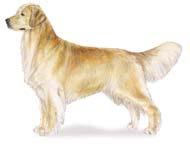 Golden
Retriever Golden
Retriever
The Golden Retriever, with its
intelligence and eager to please attitude, is one of the most popular breeds
in the United States according to
AKC®
registration statistics. The working ability that has made the Golden
Retriever such a useful hunting companion also make him an ideal guide,
assistance and search and rescue dog. The golden-colored coat is the
hallmark of this versatile breed, and can range from light to dark gold.
A Look Back
The Golden Retriever originated in the Scottish Highlands in the late 1800s
and was used predominantly for hunting. The breed was developed by Lord
Tweedmouth, whose goal was to create a superb retriever suited to the
Scottish climate, terrain and available game. He crossed his original
"Yellow Retriever" with the Tweed Water Spaniel (now extinct)
found on his estate. Later integrations of Irish Setter, Bloodhound, and
more Tweed Water Spaniel produced the retriever we know today.
Right Breed for You?
This active and energetic Sporting breed can adapt to many different living
situations but requires daily exercise. His water-repellant double-coat
sheds seasonally and needs regular brushing. With his friendly temperament
and striking golden color, this breed is both beautiful to look at and a joy
to own. |
|
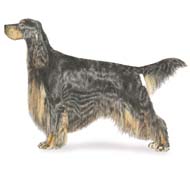 Gordon
Setter Gordon
Setter
The heaviest of the three
setter breeds, the Gordon Setter was originally bred as a personal bird dog,
but they are equally at home as companion dogs, obedience competitors and
show dogs today. Sturdy and muscular, the Gordon suggests strength and
stamina rather than extreme speed while on the move. The breed’s
distinctive black and tan coat allows it to be found easily in light fields
and early snow.
A Look Back
The Gordon hails from Scotland, and his ancient lineage traces back to the
early 17th century. Popular among hunters of Scotland, the black-and-tan
Setter came into prominence in the kennels of the fourth Duke of Gordon in
the early 19th century. As field trials became more popular, the Gordon’s
popularity waned in favor of Pointers and other flashy, fast breeds, but the
breed remained unparalleled as a one-man shooting dog.
Right Breed for You?
Alert and confident, the Gordon Setter is devoted to his family. Although
they are bright, they are not blindly obedient, so may appear stubborn.
Gordons are capable of adapting to a variety of living situations, but need
plenty of daily exercise on leash or in a fenced area. Regular grooming is
also necessary to prevent matting. |
|
 Irish
Red and White Setter Irish
Red and White Setter
Despite its name, the Irish Red and White
Setter is a distinct breed, not just a different colored version of the
Irish Setter. Bred primarily for the field, they should be strong,
powerful and athletic, with a keen and intelligent attitude. The coat’s
base color is white with solid red patches.
A Look Back
Known in Ireland since the 17th century, the Red and White is thought to
be the older of the two Irish Setters. However, due to the overwhelming
popularity of its solid red cousin, and separate breeding of the two
breeds, the Irish Red and White Setter was nearly extinct by the end of
the 19th century. During the 1920s, efforts were made to revive the Irish
Red and White Setter and by the 1940s, the breed began to reemerge in
Ireland.
Right Breed for You?
Courageous, spirited and determined, the breed’s energy in the field
carries over to the home, so Red and White Setters require regular
exercise. Their kind and friendly attitudes make them great family dogs.
They need minimal brushing or trimming – owners prize a natural
appearance and the breed tends to carry less coat than the Irish Setter. |
|
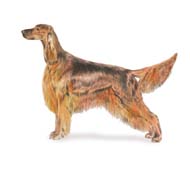 Irish
Setter Irish
Setter
One of the most distinctive Sporting
breeds, the mahogany red Irish Setter is an active, aristocratic bird dog.
Originally bred to be red and white, the solid red color appeared in
Ireland the 19th century and became a mark of quality and superior
sporting ability. Over two feet tall at the shoulder, the Irish is known
for his style, powerful movement and clown-like personality.
A Look Back
The Irish Setter became popular in the 18th century throughout Ireland and
the British Isles. Developed from a mix of Irish Water Spaniel, Irish
Terrier, English Setter, Spaniel, Pointer, and a dash of Gordon Setter,
the breed was originally used to "set" game, crouching low near
the birds so that the hunters could walk up and throw a net over bird and
dog. When firearms were introduced, the Irish adapted into a gun dog that
pointed, flushed and hunted in an upright stance.
Right Breed for You?
A rollicking breed, the Irish Setter is high-energy and requires regular
exercise. His outgoing and stable personality make him a favorite with
families. Their long, glossy red coat, although beautiful, must be groomed
regularly to prevent snarls or mats. |
|
 Irish
Water Spaniel Irish
Water Spaniel
The clown of the spaniel family, the
Irish Water Spaniel will think of creative ways to accomplish even the
slightest of tasks. Strong and intelligent, the tallest spaniel breed
possesses several unique characteristics – its liver-colored curly coat
and signature "rat tail." The water-repellant double coat
consists of dense, tight ringlets with a topknot of long, loose curls and
a smooth face. The "rat" tail is thick and covered with curls at
the base, tapering to a fine point covered with short, smooth hair.
A Look Back
A dog of ancient lineage, there is evidence of Irish Water Spaniel-type
remains going back as far as the 7th and 8th centuries AD. In the late
1100’s, dogs found in southern Ireland below the River Shannon were
called Shannon Spaniels, Rat-Tail Spaniels or Whip-Tail Spaniels, among
other things. Records document the "Water Spagnel" with
"long, rough, curled hair and a tail somewhat bare and naked."
Today’s IWS is a true dual-purpose hunting dog, as qualified with upland
game as with waterfowl.
Right Breed for You?
A typical Sporting dog, the Irish Water Spaniel is an active and energetic
companion. He possesses the natural instinct to please, making him
relatively easy to train, but regular exercise is important. Suitable for
allergy sufferers, their hypoallergenic coats require brushing every few
weeks and trimming every two months to neaten and shape the coat. |
|
 Labrador
Retriever Labrador
Retriever
The gentle, intelligent and
family-friendly Labrador Retriever from Canada continues to be the most
popular breed in the United States, according to
AKC®
registration statistics. This versatile hunting breed comes in three
colors – yellow, black and chocolate – and because of his aptitude to
please his master they excel as guide dogs for the blind, as part of
search-and-rescue teams or in narcotics detection with law enforcement.
A Look Back
Labrador Retrievers, originally from Newfoundland, were initially used in
work alongside fisherman, helping to pull in nets and catch fish that
escaped from fishing lines. After being crossed with Setters, Spaniels and
other Retrievers, the Labrador Retriever honed its skills as a true
retriever. From this point in the breed’s history, "Labs," as
they are affectionately called, were bred primarily to perform as an
efficient retriever of game, with a stable temperament suitable for a
variety of activities beyond hunting.
Right Breed for You?
An ideal sporting and family dog, the Labrador Retriever thrives as part
of an active family or as a trusted hunting companion. A double-coated
breed which sheds seasonally, regular grooming keeps his coat at its
water-resistant best. Because of his even temperament and trainability
millions of Americans own a Labrador Retriever as a pet. |
page 1
page 3
(breed information from the AKC website)

|